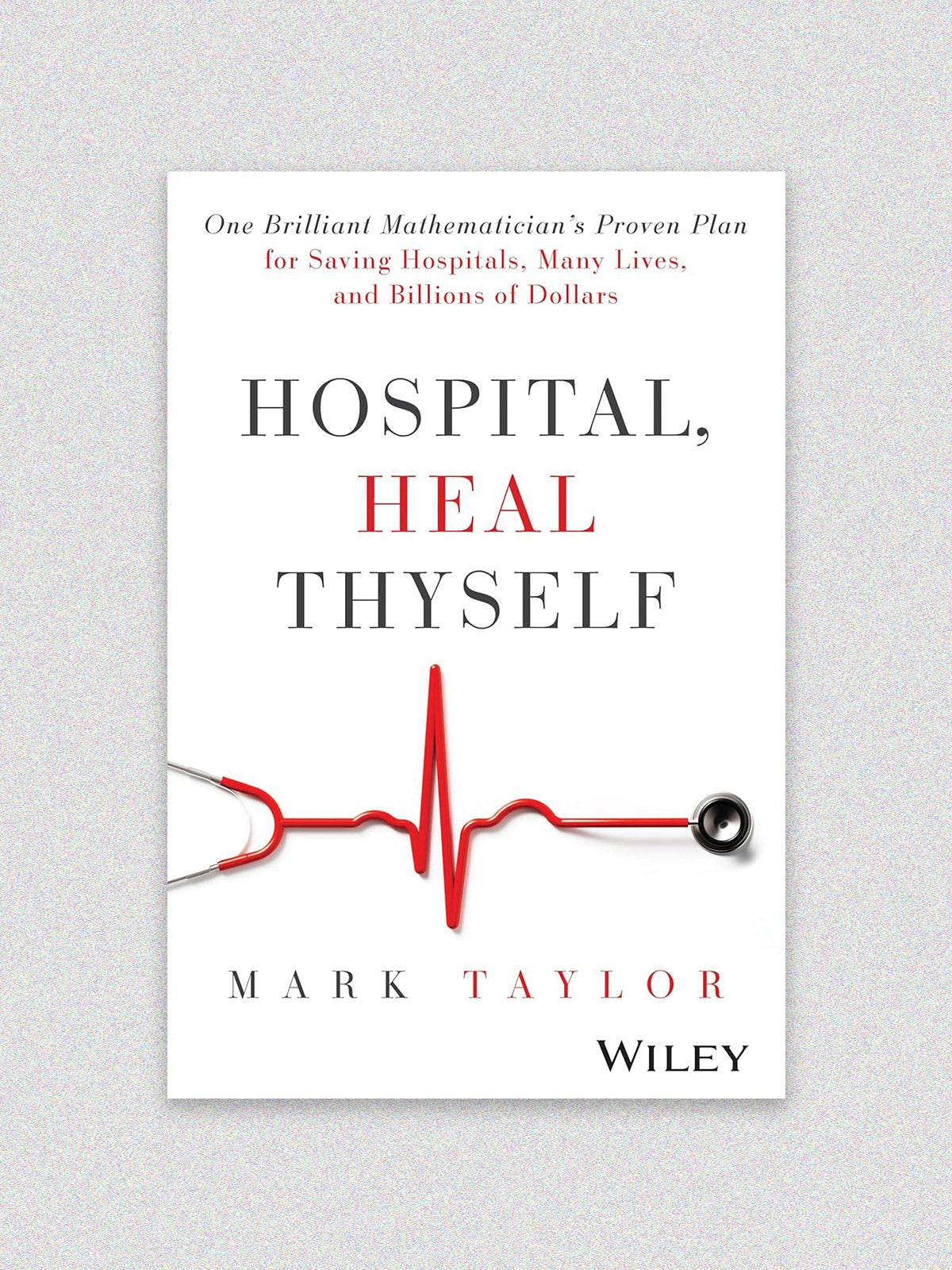
Feature
Smoothing the way
When Eugene Litvak was working as a consultant with Massachusetts General Hospital in the 1990s, he observed the institution’s inefficiencies and saw a problem he could solve. Born in Ukraine, he immigrated from the Soviet Union in 1988; he worked as systems engineer and a researcher at the Harvard School of Public Health and Boston University before setting up his consultancy. At MGH, he noticed that demand for inpatient beds would fluctuate, sometimes dramatically. Over time, he came to see these fluctuations as a result of not disease prevalence or patient load but of a hospital’s own culture and practices.
Litvak cofounded the Institute for Healthcare Optimization in 2009, which works with hospitals in the U.S. and Canada to help smooth patient flow. The organization identifies seemingly small operational changes that get big results, such as spreading out scheduling of elective surgeries over the course of the week. His work has led to multimillion-dollar annual savings for hospitals—and substantial improvements in patient care.
A forthcoming book, Hospital, Heal Thyself: A Mathematician’s Plan for Saving American Lives and Billions of Dollars, written by veteran health care journalist Mark Taylor, charts how Litvak developed his methods and makes a compelling case that they should be applied more widely. The excerpt below describes his work with Cincinnati Children’s Hospital, the institution that has thus far most broadly embraced his operational changes. At a time when hospital systems are under immense strain from patient overcrowding, health worker burnout, and resource scarcity, the changes at Cincinnati Children’s Hospital a model that could be more widely applied.
–Amy Roeder
Sign up for Harvard Public Health
Delivered to your inbox weekly.
In 2006 the president and CEO of Cincinnati Children’s Hospital, Jim Anderson, realized his hospital faced a daunting crisis. At the time, few outsiders would suspect anything amiss. The prestigious institution, routinely ranked among the best pediatric hospitals in America, seemed healthy. Admissions—from U.S. patients, but also from around the world—were rising and revenue was growing. But several times each week, the hospital mysteriously became packed beyond capacity.
Anderson grew concerned when he heard from transplant surgeon Fred Ryckman. During overcrowding episodes, the hospital’s care sometimes plummeted to an “inadequate and inefficient” level, Ryckman told him. This was an alarming development from an institution that considered itself world class.
The Cincinnati Children’s Hospital has been caring for children since 1883. But in 2006, when the 425-bed hospital (700 beds today) contracted with Eugene Litvak and the not-for-profit Institute for Healthcare Optimization (IHO), it was facing routine overcrowding issues, a problem vexing hospitals throughout the United States. Anderson realized that the hospital could not keep up with the growing patient volume and maintain its high standards. When a surge of new patient arrivals swamped the facility, overstressed clinicians—doctors and nurses—were more likely to make mistakes. Anderson foresaw an escalating cycle of higher costs and more expansion. Plans were already underway to build a 75-bed unit for around $102 million. He knew from years spent in healthcare that the new wing wouldn’t permanently fix the problem and overcrowding would return and pressure his staff, potentially leading to deteriorating quality of care.
Eventually, something could go disastrously wrong. “I was tired of seeing children coming in sick and having trouble getting into our operating rooms,” surgeon Ryckman said. “If you delay a patient’s treatment by more than six hours, their mortality rate goes up. If you delay entry to a hospital room, risk and mortality also go up. There is much data to support that it’s a bad idea to make people wait.”
Anderson, a business lawyer who worked for manufacturing powerhouse Emerson Electric Company before joining the hospital, wanted to reverse what he feared could become a severe problem. When he hired Litvak, a Harvard professor and the president and cofounder of the Boston-based IHO, he hoped to see a plan for improving patient flow—the journey from hospital admission through discharge. He knew that creating a better, more streamlined patient flow process could reduce overcrowding and decrease the risk of bad outcomes.
What Anderson got was much more: a roadmap to improving performance at the medical center, but one that could be deployed across the entire American healthcare system, saving many lives and billions of dollars in unnecessary spending.
Litvak said that the Cincinnati Children’s Hospital, like most American hospitals, recorded a daily patient census that, on paper, resembled an electrocardiogram exam, with bed occupancies that could vary as much as 80 percent from one day to the next, typified by huge peaks and deep valleys. As an applied mathematician who studied queuing, reliability and graph theories in his native Ukraine during the Soviet Era, Litvak knew that variability meant trouble. Cancelled surgeries. Crowded hospital emergency rooms. A lack of hospital beds to admit new patients. That variability causes stress on nurses and physicians due to unpredictable schedules and long hours, leading to burnout, early retirements, and nursing shortages. It meant diverting ambulances transporting sick and dying patients to other ERs, putting the patient lives at risk and costing the intended hospitals millions in lost revenue. It meant “boarding” ER patients in hallways for hours, sometimes days, aggravating patient conditions and even costing lives. It meant medical errors, malpractice lawsuits and sinking reputations.
The United States ranks near the bottom of industrialized nations in average hospital bed occupancy, hovering between 64 percent and 68 percent, according to Organization for Economic Cooperation and Development (OECD), an intergovernmental economic organization comprised of 36 developed nations. Out of 28 nations, the U.S. ranked 27th, only ahead of Greece. Ireland, Israel and Canada topped the list in 2017, with occupancy rates that ranged between 95 percent (Ireland) to 91.6 percent (Canada).
“Yet we’re still overcrowded. Why?” Litvak asked. “Because of the artificial peaks in patient demand. If we could manage patient flow more effectively, our average daily census could be around 80 percent nationally. The number of Americans who are uninsured is around 10 percent to 12 percent. If we could solve this, we could cover hospital care for the uninsured with the savings from hospital spending.”
Litvak and his team of IHO analysts gathered hospital data and crunched numbers, applying complex algorithms and mindnumbing mathematical theories to analyze what was happening with the hospital’s patients. The IHO team’s main goal was to understand and document how Cincinnati Children’s Hospital handled its patient flow. How do managers schedule surgeries, both elective (planned) and emergency (unscheduled)? What causes all those patient surges, the peaks and valleys? Are they predictable, and how should the hospital respond to ease the burden on its doctors, nurses, and patients?
More than a decade earlier Litvak made the connection between patient demand and hospital capacity using his stealth but not-so secret weapon: math. After helping several other hospitals improve their patient outcomes and save millions of dollars, he sought to apply those same tools to Cincinnati Children’s Hospital. Only this time, it wouldn’t be applied in just one department as other hospital clients did; it would be integrated throughout the entire hospital.
Hospitals are complicated organizations that often employ thousands [of people] throughout multiple departments. They are dependent upon costly information technology, employ the latest sophisticated and expensive medical equipment—some costing millions of dollars—and require the collaboration and continuity of a symphony orchestra. For decades, individual hospital departments—surgery, oncology, cardiology, to name a few—operated like individual fiefdoms or silos, jealously guarding their territory, revenue streams, and staffing. As long as the hospital prospered, that system worked. But recent changes in hospital reimbursement by insurers, both public (Medicare and Medicaid) and private (Aetna and United Healthcare, for example), are compelling hospitals to deliver higher quality patient care at lower costs.
These financial pressures have driven medical centers like Cincinnati Children’s Hospital to make dramatic changes in how they plan to treat patients. In the past two decades many hospitals have sought out process improvement through programs like General Electric’s Six Sigma and Toyota’s Lean. These programs are common in the manufacturing world, but somehow escaped adoption by the healthcare industry until recently. Anderson was puzzled by the scarcity of programs to improve patient flow. But IHO’s trial run impressed him. He said the results were astonishing.
Litvak remembers telling Anderson and Scott Hamlin, the hospital’s chief financial and administrative officer, that the surgeons would meet and vote yes or no on the full project implementation. “I talked individually with each chief of every surgical subspecialty and to each I spoke with, there was a trick,” Litvak recalled. “I told them that their unit would benefit more than anyone else. It was not true that one would benefit more than anyone else, but all would benefit. For some people, however, it is important to come out ahead of everyone else.”
Ryckman said that back then, few understood the link between poor patient flow and patient safety. He said the greatest risks to hospitals occur when the care they deliver produces bad outcomes and inadequate care to patients.
“And in the early days, before we changed, we were offering inadequate and inefficient care. The financial risk is also substantially higher when delivering bad care.” Ryckman pointed out another big risk: headlining the front page of your local newspaper because a patient sat for six hours in the ER and suffered a bad outcome.
He felt that one of the most unappreciated and most important resources any hospital was quality nursing care. “Within our hospital, Litvak’s program has been a driver for nurse retention. Our nurses don’t have to routinely work overtime. It doesn’t make OT go away but makes it less of a problem. It really changed the way we thought and planned,” Ryckman said.
Annual revenue at Cincinnati Children’s Hospital rose by more than $100 million during a period when patient volume rose significantly, all without Cincinnati Children’s Hospital having to spend $102 million on its planned patient tower, which was no longer needed. Its average daily occupancy increased from 76 percent to 91 percent, much higher than the U.S. hospital average. Litvak’s methods smoothed the peaks and valleys of the daily census to a more predictable middle level, making it easier for hospital management to staff appropriately and easing the stress on nurses and physicians and, in the process, reducing the likelihood of medical errors.
Hospital officials said that waiting times in the emergency room and the operating rooms reduced significantly, expanding the hospital’s capacity to treat more patients while improving quality. “There are fewer mistakes and adverse incidents, and the surgeons are happier because fewer of their scheduled surgeries are canceled,” Anderson said, predicting that if Litvak’s methods were applied to every hospital in America, “We would see enormous increases in capacity, while saving billions of dollars nationally.”
Excerpted with permission of the publisher, Wiley, from Hospital, Heal Thyself: One Brilliant Mathematician’s Proven Plan for Saving Hospitals, Many Lives, and Billions of Dollars by Mark Taylor. Copyright © 2024 Mark Taylor. All rights reserved.
Book cover: Wiley


